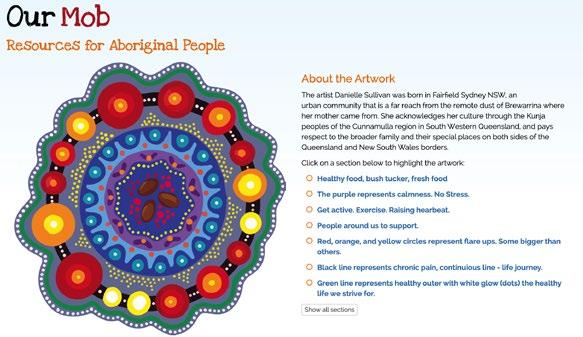
4 minute read
NUTRITIONAL CONSIDERATIONS FOR INDIGENOUS AUSTRALIANS
from APS NOV19 eNews
by auspainsoc
BY KATHERINE BRAIN, KERITH
DUNCANSON, LAURA BRUGGINK, CLARE COLLINS
Katherine is an Accredited Practising Dietitian and Research Academic in Nutrition & Dietetics at the University of Newcastle. Kerith is an Accredited Practising Dietitian and Postdoctoral Research Fellow at the University of Newcastle. Laura is an APA Titled Pain Physiotherapist who works with Hunter Integrated Pain Service and involved in running a brief pain management program for CALD populations in the Hunter. Prof Clare Collins is a Fellow of the Dietitians Association of Australia and Senior Research Fellow in Nutrition & Dietetics in the Faculty of Health and Medicine at the University of Newcastle.
Indigenous Australians are 1.5 times more likely to have osteoarthritis and 25% more likely to have lower back pain compared to non-Indigenous Australians1. Overall, Indigenous Australians experience burden of disease 2.3 times that of non-Indigenous Australians1. Almost 40% of this burden is preventable by reducing exposure to modifiable risk factors such as dietary intake1, and were not reported in Australia prior to colonisation.
The Agency for Clinician Innovation website, Our Mob, displays an Indigenous artwork which incorporates key messages for chronic pain (Figure 1)2. Healthy food, bush tucker, and fresh food is represented in the centre of the artwork, highlighting the importance of nutrition2.
Traditional vs contemporary interpretations of the wholeperson approach to pain management
1. Biomedical: Health goes beyond physical wellbeing and includes social, emotional, spiritual, and the cultural wellbeing for the whole community3,4. It encompasses a holistic approach3,4. In contrast, the contemporary health care system largely focuses on the clinical aspect. There can be a sense of loss of traditional holistic wellbeing leading to an increase burden from chronic disease3,4.
2. Mindbody: Traditionally Indigenous people focus on social and emotional wellbeing with emphasis on spiritual health and dreamtime3,4. However, the contemporary way of addressing mindbody issues is to focus on mental health problems, rather than what influences the problem. There is also a huge sense of discrimination, grief, and loss which increases the prevalence of mental health issues3,4
3. Connection: Connection to family, community, spirituality and to the land which is extremely important but has been taken away through history (e.g. stolen generation)3,4. This loss of connection has isolated Indigenous people from their traditional foods and way of eating. The loss of connection can lead to increases in trauma, which in turn, can lead to worsened pain experiences.
4. Physical activity: Traditionally Indigenous people see physical activity as moving with purpose, team games, and dance whereas non-Indigenous people see it as exercise and sport5. Different meanings can reduce the emphasis on movement, leading to a more sedentary lifestyle where hunting and gathering for food is no longer needed5
5. Nutrition: Indigenous Australians value food, especially nutrient rich food and their way of eating is to graze and share food, ensuring sustainable practices5. From a health professional perspective, non-Indigenous Australians focus more on nutrition and energy balance, and are more likely to be health orientated when it comes to food5. Modern eating patterns have also led to increased availability of energy-dense nutrition-poor foods.
An example: A Nutraditions Approach
In order to show that a traditional diet can align with Australian Dietary Guidelines, the ‘Nutraditions’ project was undertaken in the Worimi and Biripi nations located in the Mid-North Coast in NSW5. Aboriginal Elders and knowledge keepers collaborated with local nutritionists to match traditional foods with contemporary options; for example, from a nutrition perspective, Warrigal greens are similar to Chinese cabbage and the Bogong moth is similar to pumpkin seeds5. Contemporary alternatives were also incorporated into the traditional meal pattern of one main meal, one small meal, and grazing foods.
This project empowered elders, retained Indigenous knowledge, motivated Indigenous people to change eating habits, increased pride and culture, and generated interest in and respect for traditional foods and diets from non-Aboriginal people5.
Summary
The best way to address Indigenous health issues is to combine the expertise from Indigenous elders, Aboriginal health workers, and Indigenous communities with clinicians, evidence, researchers and government. By empowering Indigenous people there will be greater successes and better outcomes.
When communicating with Indigenous clients be aware, understand, and respect the differences in culture. Collaborate with Aboriginal people at every stage, be mindful of white privilege, aim to increase your cultural awareness and competence, use appropriate language, and seek to understand. Be aware that the emphasis of time varies between Indigenous and nonIndigenous cultures and that silences are considered normal and valued. Use a ‘yarn’ style of communicating focusing around conversation and story based.
Resources
• Agency for Clinical Innovation: https://www.aci.health.nsw.gov.au/ chronic-pain/our-mob
• Australian Pain Society: https://www. apsoc.org.au/Indigenous-Resources
• Dietitians Association of Australia: https://daa.asn.au/smart-eatingfor-you/smart-eating-fast-facts/ healthy-eating/health-and-wellbeingof-aboriginal-and-torres-strait-islanderpeople/
• Queensland Health: https://www. health.qld.gov.au/data/assets/pdf_ file/0021/151923/communicating.pdf
Acknowledgements
The authors would like to acknowledge and thank the Indigenous elders and Accredited Practicing Dietitians who made Nutraditions possible.
References
1. AIHW 2018. Australia’s health 2018. Australia’s health series no. 16. AUS 221. Canberra: AIHW.
2. ACI. Out Mob. Available from: https:// www.aci.health.nsw.gov.au/chronic-pain/ our-mob
3. Gee, G et al. (2014). Aboriginal and Torres Strait Islander social and emotional wellbeing. In Dudgeon, P et al. (Ed.), Working together: Aboriginal and Torres Strait Islander mental health and wellbeing principles and practice (2nd ed., pp. 55-68).
4. Australian Department of Health and Ageing. (2013). National Aboriginal and Torres Strait Islander Health Plan 2013-2023.
5. Duncanson, K et al. (2014). Nutraditions: Does a traditional worimi diet achieve the current Australian dietary guidelines? JNIM. 1. 28.
Declarations
• Katherine Brain was supported by an Australian Postgraduate Award and Hunter Medical Research Top Up Scholarship during her PhD (2015-2018).
• Kerith Duncanson has nothing to declare.
• Laura Bruggink has nothing to declare.
• Professor Clare Collins is a NHMRC Senior Research fellow (2016-2020) and a Gladys M Brawn Senior Research Fellow in the Faculty of Health and Medicine at the University of Newcastle.






